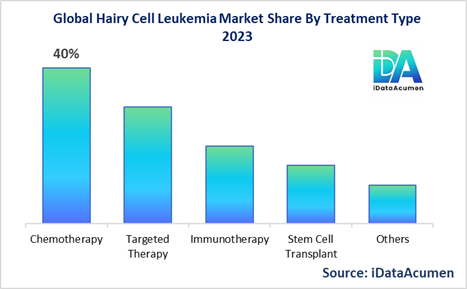Hairy Cell Leukemia Market Expected to Achieve US$ 506.8 Mn by 2031 with a growing CAGR 8.7%. Hairy Cell Leukemia Market is a niche segment within the pharmaceutical industry, focused on developing and commercializing treatments for this rare form of chronic lymphocytic leukemia. Hairy cell leukemia is characterized by the abnormal proliferation of B-lymphocytes, leading to complications such as an enlarged spleen, low blood cell counts, and an increased risk of infections.
The market's growth is fueled by several factors, including the rising prevalence of hairy cell leukemia due to an aging population and improved diagnostic capabilities. Additionally, advancements in targeted therapies and immunotherapies have revolutionized the treatment landscape, offering more effective and less toxic options compared to traditional chemotherapy regimens. The development of these novel therapies has attracted significant investment from pharmaceutical companies, driving market expansion.
The Hairy Cell Leukemia Market is poised for substantial growth in the coming years, fueled by an increasing demand for targeted and personalized treatments, ongoing research and development activities, and a growing emphasis on improving patient outcomes and quality of life. The market dynamics are driven by a confluence of factors, including an aging population, advancements in diagnostic techniques, and the emergence of innovative therapeutic approaches. Furthermore, the market presents significant opportunities for pharmaceutical companies to address unmet medical needs, develop combination therapies, and explore strategic partnerships to accelerate drug development and commercialization.

Drivers:
- Increasing Prevalence and Aging Population: The rising incidence of hairy cell leukemia, coupled with an aging global population, is a major driver for market growth. According to estimates, the incidence rate of hairy cell leukemia is around 0.3 per 100,000 individuals per year in the United States, and the risk increases with age.
- Development of Targeted Therapies: The advent of targeted therapies, such as kinase inhibitors and monoclonal antibodies, has revolutionized the treatment landscape for hairy cell leukemia. These therapies offer improved efficacy, fewer side effects, and better quality of life compared to traditional chemotherapy regimens, driving market growth.
Trends:
- Increasing adoption of immunotherapies for the treatment of hairy cell leukemia.
- Focus on improving patient quality of life through the development of more targeted and less toxic therapies.
Market Opportunity: Exploration of combination therapies and strategic partnerships between pharmaceutical companies and research institutions to accelerate drug development and address unmet medical needs in the hairy cell leukemia market.
Key Report Insights:
- North America is the largest region for the Hairy Cell Leukemia Market, accounting for over 40.2% market share. Prominent companies with a strong presence in this region include AstraZeneca, Novartis, and Roche. The market growth in North America is driven by factors such as advanced healthcare infrastructure, better diagnostic capabilities, and increased awareness among healthcare professionals.
- Europe is the second-largest region for the Hairy Cell Leukemia Market, with a market share of 28.5%. Companies like Bayer, Pfizer, and GlaxoSmithKline have a significant presence in this region. The growth in Europe is attributed to the availability of advanced treatment options, favorable reimbursement policies, and increasing research and development activities.
- Prominent companies operating in the Hairy Cell Leukemia Market include AstraZeneca, Novartis, Roche, Bayer, Pfizer, Sanofi, GlaxoSmithKline, Merck & Co., Bristol-Myers Squibb, and Janssen Pharmaceuticals (Johnson & Johnson).
Market Segmentation:
- By Treatment Type
- Chemotherapy
- Targeted Therapy
- Immunotherapy
- Stem Cell Transplant
- Others (Supportive Care, Radiation Therapy)
- By Route of Administration
- Oral
- Parenteral
- Others (Topical, Inhalation)
- By End-user
- Hospitals
- Specialty Clinics
- Ambulatory Surgical Centers
- Others (Research Institutes, Academic & Government Organizations)
- By Distribution Channel
- Hospital Pharmacies
- Retail Pharmacies
- Online Pharmacies
- Others (Direct Tenders, Government Suppliers)
- By Mechanism of Action
- Purine Analog
- Monoclonal Antibodies
- Kinase Inhibitors
- Interferon Therapy
- Others (Immunomodulators, Alkylating Agents)
- By Region
- North America
- Europe
- Asia Pacific
- Latin America
- Middle East & Africa
Definition:
“The Hairy Cell Leukemia Market refers to the industry that encompasses the development, manufacturing, and commercialization of various therapeutic products and services for the treatment of hairy cell leukemia, a rare and slow-growing type of blood cancer. This market focuses on providing effective and targeted therapies, such as chemotherapy, targeted agents, immunotherapies, and stem cell transplants, to manage and potentially cure this disease. The market includes pharmaceutical companies, biotechnology firms, research institutions, and healthcare providers involved in the research, development, and delivery of treatments for hairy cell leukemia patients worldwide. It is a niche market due to the low prevalence of the disease, but it is crucial in addressing the unmet medical needs of this patient population and improving their overall survival and quality of life.”